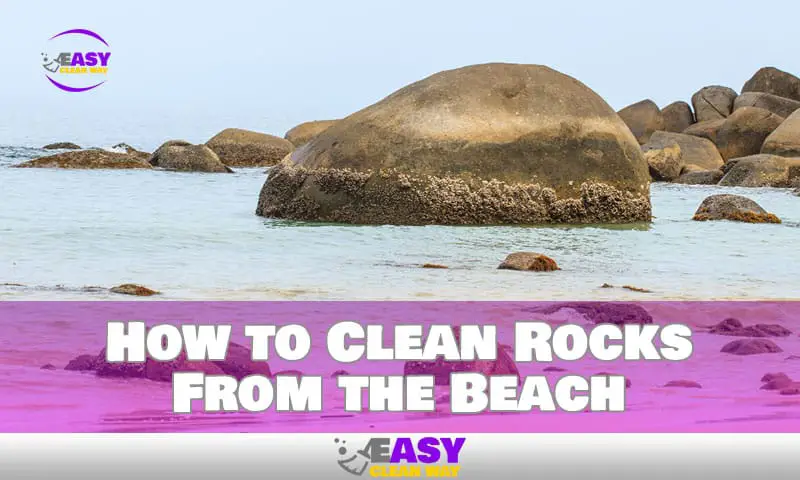Have you ever taken a stroll down the beach and stumbled upon some rocks that took your breath away? If yes, you must have found yourself wondering how to keep them clean for years to come.
Well, look no further! Keeping those special pieces of nature shiny and new requires a few steps. The good news is that it’s not as hard as you might think. In this article, we’ll provide a step-by-step guide on how to clean your sea treasures without damaging them.
Whether you plan on putting your lovely rocks on display or giving them away as gifts, we’ll make sure they look just like the day you found them (or even better!) in no time.
Tips for Cleaning Rocks on the Beach
Bringing home a few beach treasures is always a great way to remind yourself of your special time by the shore. But if you want them to look their best when you get them home, it’s helpful to know how to clean rocks from the beach correctly.
Soaking rocks in soapy water for a day can help loosen any packed-in dirt and debris that needs to go. For smaller surfaces, an abrasive toothpaste is great for dislodging any stubborn grime.
Normal hydrogen peroxide found in drugstores works well to get rid of black or brown manganese stains! Due to the flammability of hydrogen peroxide, it’s crucial to ensure adequate ventilation and clear the area of any combustible materials before applying it. Your beach rocks and seashells can be returned to their original state, though, if you take these precautions and have a little patience.
Gathering Your Beach Rocks
Winter and early spring are the best times to visit if you enjoy beach rockhounding because the tides are lower and more of the shoreline is visible. Just make sure to collect responsibly; some ecological reserves don’t permit it at all. To start, check the local laws. Start your first collection of rocks if you’re a Midwesterner looking for some in Michigan, which is known for having some of the best beaches for rock hunting.
Now that you’ve gathered your supplies and beach rocks, what’s next? Before you can proudly display your sea treasures in your home or garden, you’ll need to clean them up. Here’s how it’s done:
- Fill a bucket or sink with cool water and add a couple of drops of mild soap or detergent.
- Place the rocks in the water and let them soak for 5-10 minutes.
- Scrub away any dirt or debris with an old toothbrush.
- Rinse off with cool running water.
- Let them dry completely before displaying.
Carefully Removing Dirt and Sand From the Beach Rocks
One of the most important parts of cleaning beach rocks is carefully removing dirt and sand without damaging them. Sure, you can rinse off the rocks with water, but if you’re looking for a deeper clean, here are some tips:
Boiling Water
Boiling water can help loosen bits of dirt and sand that have become caked onto the rocks. Boil two or three cups of water in a pot or kettle and pour it slowly over the rocks. Be careful not to pour boiling water directly onto one particular rock, as it could crack or break.
Abrasive Toothpaste for Smaller Surfaces
If you want to get into the smaller crevices and grooves, try using an abrasive toothpaste. Just give them a once-over with a soft-bristled toothbrush dipped in toothpaste and warm water, then rinse with cold water afterward.
Nylon Brushes
Using nylon brushes is safe on most stones without damaging them. Just rub gently in circular motions to remove dirt without causing scratches. Make sure to rinse off the brush regularly during cleaning and rinse the stones thoroughly afterward to remove any residue from the brush bristles.
Rinsing Off the Beach Rocks
Once you’ve gotten as much dirt and gunk off the rocks as possible, it’s time to give them a good rinse. Boiling water does wonders for loosening everything up, and you can even add in a gentle cleaning agent like dish soap or laundry detergent to give those small landscape rocks an extra scrub. For river rocks that have some algae on them, use a mixture of equal parts vinegar and water or a mild bleach solution to help dissolve that pesky algae.
Finally, you’ll want to make sure you get rid of any of the soap and/or chemical residue before putting your clean rocks back into their natural environment—you don’t want them to harm any wildlife or disrupt the ecosystem! To do this, simply fill a bucket with clean water and swish the rocks around until there’s no soapy or bleachy feeling left on them.
Now your sea treasures are all squeaky-clean and ready for display; simply find a place for them in the garden or inside your home—the possibilities are endless.
Applying a Protective Sealant
If you want to add an extra layer of protection to your sea treasures, you should apply a protective sealant. This will ensure that your rocks remain in good condition even after long periods of exposure to the elements.
When applying sealant, you have to be sure to do it correctly. Make sure that the paint is completely dry, which usually takes at least 24 hours. If you don’t wait long enough and apply the sealant too soon, then your paint won’t adhere properly, and the end results won’t be as good.
When selecting your sealant, try to stick with a water-based variety for best results; this will provide a durable seal without leaving a sticky residue or any odors behind that might bother you or your family members. Also, make sure that you are applying it in a ventilated environment with temperatures at least 50°F (10°C).
After these steps are taken care of, all you have to do is give your sea treasures one final coat of protection by gently misting the rocks with the sealant and allowing them to dry for several hours before displaying them proudly.
Reusing and Repurposing Your Beach Rocks
Another thing you might not know is that all the beach rocks you collect can be upcycled, reused, recycled, and repurposed for DIY projects.
So what kind of projects can you make with rocks from the beach? The possibilities are limitless! For example, if you love the outdoors, you can beautify your outdoor spaces with items found on the beach. Transform your outdoor space by lining garden paths and flower beds with rocks. Rocks can even be used to create a beautiful focal point in a garden or mixed with Adirondack chairs to create an eclectic sitting area.
What’s even cooler is that it’s part of nature’s cycle. Natural selection is the process of recycling rocks—they’re tumbled by waves and sand until they become smooth and perfect for use in DIY projects. So why not give them new life by hiding them in your garden or creating something decorative out of them?
People Also Like: How to Clean Darts Perfectly to Keep Mind-blowing
Conclusion
When it comes to cleaning your sea treasures, the best approach is to be mindful of the types of rocks you’re bringing home. As long as you’re using the right techniques and products, you’ll be able to bring your finds back to life, and proudly display your chosen rocks in a special place. It’s a great way to create an unforgettable memory of your beach adventures, and it’s a fun hobby that you can share with your family and friends. Plus, you’ll get to enjoy a sparkly reminder of the beauty of the sea, even when you’re far away from it.
Hey there! I’m Alton Smith, your Clean Expert blogger. I’m on a quest to help you conquer chaos and embrace the joys of a tidy life.





